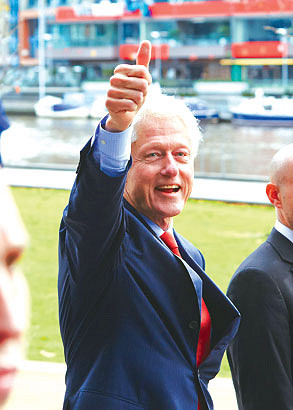
Southbank lights up for AIDS 2014
In what was otherwise a great cause for celebration, the launch of Melbourne’s AIDS 2014 experience on Friday, July 18, was marred by a shocking tragedy.
Less than a day out from the official opening of the 20th international AIDS conference, the world was brought to a stand still after 298 lives were lost on board flight MH-17.
The news was only made worse for organisers, with seven passengers said to have been traveling to Melbourne to take part.
Among those killed was leading Dutch researcher Joep Lange, former president of the International AIDS Society and director of the Amsterdam Institute for Global Health and Development.
Speaking at the launch of a special digital art installation at Southbank’s Hamer Hall, Victorian Premier Denis Napthine was among a number of distinguished figures to pay tribute.
“This is a massive loss to our community who work together across the world to tackle this terrible tragedy,” he said.
“The lighting up of Hamer Hall celebrates the many great achievements that have been made by scientists, researchers, sociologists and advocates around the world.”
Titled Honouring the past, hope for the future: Toward an HIV Free Generation, the light projection was the initiative of YEAH, an Australian Youth Health Organisation.
The group’s CEO, Alischa Ross, said she hoped the display would help inspire greater action in tackling HIV/AIDS.
“I hope in some way, the public space we have created and dedicated to HIV awareness right here in the centre of our city will become a symbol for community solidarity and a positive memory of how we rallied together in this difficult time to rise up and to make a difference.”
Hundreds gathered as Hamer Hall and Princes Bridge was illuminated in typical AIDS red, with some laying flowers and lighting candles for the victims.
But indeed, rather than defuse efforts, the tragedy of MH-17 only caused participants to ramp them up.
Some 13,000 delegates and experts from more than 200 countries gathered at Melbourne Convention and Exhibition Centre from the July 21 to 25.
Among the high-profile advocates to visit Southbank included former US President Bill Clinton, Sir Bob Geldof and the head of UN AIDS Michael Sidibe.
Campaigners are more optimistic than ever following the event, with their latest target aiming to end the epidemic by 2030.
While there is still no cure for HIV infection, experts say a combination of available tools could be enough to stop the virus spreading.
Speaking at the closing, AIDS 2014 co-chair Prof. Francoise Barre-Sinoussi announced that more than 14 million patients worldwide now had access to antiretroviral treatment.
Now on track to reach the UN goal of 15 million by 2015, he called for the international community to step up the pace.
“We must further our collaboration with other major international health movements at every level of the response because our objective is to build a better future for all.”
The next international AIDS conference will take place in Durban, South Africa in 2016.
For more information visit
www.AIDS2014.org

Revitalisation of Alexandra Gardens progresses

Build-to-rent development gets green light in South Melbourne






 Download the Latest Edition
Download the Latest Edition